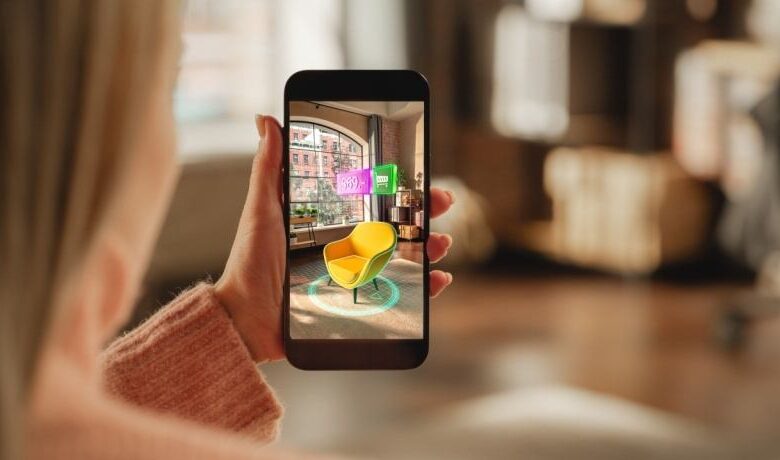What Is Location-Based Augmented Reality?


The Ins And Outs Of Location-Based Augmented Reality
Location-based Augmented Reality (AR) is a technology that overlays digital content onto the physical world based on the user’s current location. It utilizes GPS, Wi-Fi, cellular data, or other location-tracking technologies to determine the user’s position and orientation, enabling the AR system to superimpose relevant digital information onto the real-world view displayed on the user’s device, such as a smartphone or AR glasses.
How Does Location-Based AR Work?
- Location detection.
The AR application determines the user’s precise location using GPS, Wi-Fi, or cellular data. This information helps identify the user’s position on a map or within a specific area. - Content rendering.
Once the user’s location is established, the AR system overlays digital content onto the real-world view displayed on the user’s device. This content can include information, graphics, 3D models, animations, or interactive elements relevant to the user’s surroundings. - Contextual information.
The digital content rendered in location-based AR is often contextualized to the user’s environment. For example, it may provide information about nearby landmarks, points of interest, businesses, or events. - Interaction.
Users can interact with the AR content, typically through touch gestures or voice commands, to access additional information, navigate through the environment, or engage in interactive experiences.
Applications Of Location-Based AR
- Navigation and wayfinding.
This provides turn-by-turn directions overlaid onto the real world, guiding users to their destination. It can include displaying nearby points of interest, such as restaurants, landmarks, or public transportation options. - Tourism and sightseeing.
It enhances the visitor experience by providing information about historical sites, monuments, and tourist attractions. Location-based AR can offer interactive tours with Augmented Reality guides providing commentary and insights. - Gaming and entertainment.
You can create location-based AR games where players explore the real world to discover virtual objects, complete challenges, or engage in multiplayer experiences. This can include location-based events and scavenger hunts that encourage social interaction and exploration. - Retail and marketing.
It can offer location-based promotions and discounts to users when they are near a specific store or venue. Location-based AR can also allow users to visualize how products would look in their surroundings using AR try-on features. - Education and learning.
It allows users to experience Augmented Reality in education by providing contextual information and interactive lessons based on their location. This can include field trips or outdoor learning activities facilitated through location-based AR.
Benefits Of Location-Based AR
- Enhanced user engagement.
Location-based AR provides personalized and contextually relevant experiences that captivate users and encourage exploration. - Convenience and utility.
By integrating digital content with real-world locations, users can access valuable information and services at the right time and place. - Increased interactivity.
Users can interact with the environment and digital content, fostering active participation and deeper engagement. - Innovative marketing opportunities.
Location-based AR offers unique opportunities for businesses to reach and engage customers in a targeted and meaningful way.
What More Does Location-Based AR Offer?
Moreover, location-based AR has significant potential in education, where it can be used to facilitate immersive learning experiences both inside and outside the classroom. Students can engage with educational content tailored to specific locations, bringing history, science, and other subjects to life in a meaningful way. In addition to its practical applications, location-based AR also opens up new opportunities for entertainment and social interaction. Location-based AR games encourage users to explore their surroundings, solve puzzles, and interact with virtual objects in the real world. These games promote physical activity and social engagement while also providing a novel form of entertainment.
Overall, location-based augmented reality offers a compelling blend of digital and physical experiences, enhancing the way users interact with their environment and providing endless possibilities for innovation across various domains. As technology continues to advance, we can expect to see even more sophisticated applications of location-based AR that further blur the lines between the virtual and real worlds.
Conclusion
Location-based augmented reality (AR) seamlessly integrates digital content with the physical world based on the user’s location. Utilizing GPS, Wi-Fi, or cellular data, location-based AR overlays relevant information onto the real-world view displayed on the user’s device. This technology enables personalized and contextually relevant experiences, ranging from navigation and tourism to gaming and retail. By leveraging location-based AR, businesses can engage users in innovative ways, offering interactive content tailored to their surroundings. Overall, location-based AR transforms how users interact with their environment, unlocking new possibilities in navigation, education, entertainment, and marketing.
Source link



